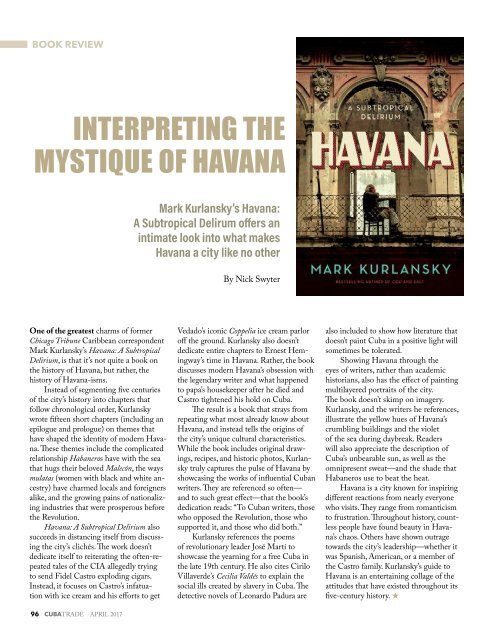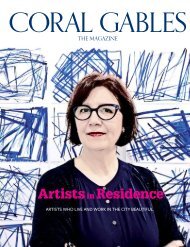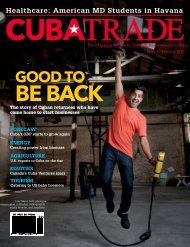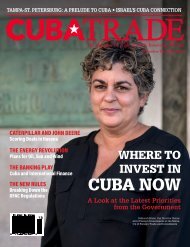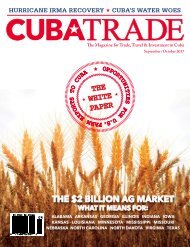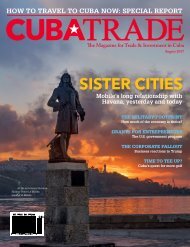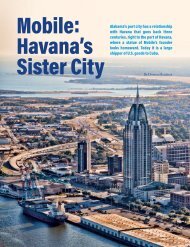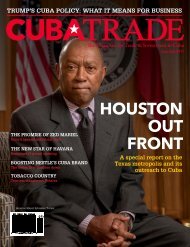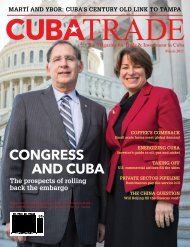CubaTrade-April2017-FLIPBOOK
You also want an ePaper? Increase the reach of your titles
YUMPU automatically turns print PDFs into web optimized ePapers that Google loves.
BOOK REVIEW<br />
INTERPRETING THE<br />
MYSTIQUE OF HAVANA<br />
One of the greatest charms of former<br />
Chicago Tribune Caribbean correspondent<br />
Mark Kurlansky’s Havana: A Subtropical<br />
Delirium, is that it’s not quite a book on<br />
the history of Havana, but rather, the<br />
history of Havana-isms.<br />
Instead of segmenting five centuries<br />
of the city’s history into chapters that<br />
follow chronological order, Kurlansky<br />
wrote fifteen short chapters (including an<br />
epilogue and prologue) on themes that<br />
have shaped the identity of modern Havana.<br />
These themes include the complicated<br />
relationship Habaneros have with the sea<br />
that hugs their beloved Malecón, the ways<br />
mulatas (women with black and white ancestry)<br />
have charmed locals and foreigners<br />
alike, and the growing pains of nationalizing<br />
industries that were prosperous before<br />
the Revolution.<br />
Havana: A Subtropical Delirium also<br />
succeeds in distancing itself from discussing<br />
the city’s clichés. The work doesn’t<br />
dedicate itself to reiterating the often-repeated<br />
tales of the CIA allegedly trying<br />
to send Fidel Castro exploding cigars.<br />
Instead, it focuses on Castro’s infatuation<br />
with ice cream and his efforts to get<br />
96 CUBATRADE APRIL 2017<br />
Mark Kurlansky’s Havana:<br />
A Subtropical Delirum offers an<br />
intimate look into what makes<br />
Havana a city like no other<br />
By Nick Swyter<br />
Vedado’s iconic Coppelia ice cream parlor<br />
off the ground. Kurlansky also doesn’t<br />
dedicate entire chapters to Ernest Hemingway’s<br />
time in Havana. Rather, the book<br />
discusses modern Havana’s obsession with<br />
the legendary writer and what happened<br />
to papa’s housekeeper after he died and<br />
Castro tightened his hold on Cuba.<br />
The result is a book that strays from<br />
repeating what most already know about<br />
Havana, and instead tells the origins of<br />
the city’s unique cultural characteristics.<br />
While the book includes original drawings,<br />
recipes, and historic photos, Kurlansky<br />
truly captures the pulse of Havana by<br />
showcasing the works of influential Cuban<br />
writers. They are referenced so often—<br />
and to such great effect—that the book’s<br />
dedication reads: “To Cuban writers, those<br />
who opposed the Revolution, those who<br />
supported it, and those who did both.”<br />
Kurlansky references the poems<br />
of revolutionary leader José Martí to<br />
showcase the yearning for a free Cuba in<br />
the late 19th century. He also cites Cirilo<br />
Villaverde’s Cecilia Valdés to explain the<br />
social ills created by slavery in Cuba. The<br />
detective novels of Leonardo Padura are<br />
also included to show how literature that<br />
doesn’t paint Cuba in a positive light will<br />
sometimes be tolerated.<br />
Showing Havana through the<br />
eyes of writers, rather than academic<br />
historians, also has the effect of painting<br />
multilayered portraits of the city.<br />
The book doesn’t skimp on imagery.<br />
Kurlansky, and the writers he references,<br />
illustrate the yellow hues of Havana’s<br />
crumbling buildings and the violet<br />
of the sea during daybreak. Readers<br />
will also appreciate the description of<br />
Cuba’s unbearable sun, as well as the<br />
omnipresent sweat––and the shade that<br />
Habaneros use to beat the heat.<br />
Havana is a city known for inspiring<br />
different reactions from nearly everyone<br />
who visits. They range from romanticism<br />
to frustration. Throughout history, countless<br />
people have found beauty in Havana’s<br />
chaos. Others have shown outrage<br />
towards the city’s leadership—whether it<br />
was Spanish, American, or a member of<br />
the Castro family. Kurlansky’s guide to<br />
Havana is an entertaining collage of the<br />
attitudes that have existed throughout its<br />
five-century history. H<br />
EDITORIAL<br />
CALENDAR 2017<br />
JANUARY- FEBRUARY<br />
Economic Predictions<br />
Top Economic thinkers from US<br />
Universities and Think Tanks<br />
MARCH<br />
The Embargo Issue<br />
Where US Congressmen<br />
and Senators line up on<br />
the question<br />
APRIL<br />
High Tech Cuba<br />
Software, telecom, biomed and<br />
pharmaceuticals<br />
MAY<br />
The Tourism Issue<br />
A look at the hospitality industry as<br />
it expands in Cuba: Hotel chains,<br />
cruise lines, private B&Bs, air transport,<br />
travel companies, etc<br />
JUNE<br />
The Cuba Advisors<br />
A comprehensive guide to the top<br />
lawyers and consultants for doing<br />
business in Cuba, from law firms to<br />
lobbyists to economists<br />
JULY<br />
Cuba’s Luxury Brands<br />
Cigars, rum, coffee and fashion, a<br />
look at Cuba’s luxury goods, and<br />
how the Cuba brand has grown<br />
worldwide<br />
AUGUST<br />
The Logistics Issue<br />
How to move things in and out of<br />
Cuba, the top transport providers,<br />
and in-depth looks at the ports of<br />
Mariel and Santiago<br />
SEPTEMBER<br />
The Energy Issue<br />
Leading sectors emerging in the<br />
near future, from oil to renewables<br />
OCTOBER<br />
The Cuba 100<br />
The top multinational corps doing<br />
business in Cuba<br />
NOVEMBER<br />
The Agriculture Issue<br />
From US exports of rice, wheat and<br />
corn, to Cuba exports of organics<br />
DECEMBER<br />
Foreign Direct Investment<br />
The top sectors–and Cuban priorities–for<br />
foreign investment<br />
Subscribe online at<br />
cubatrademagazine.com


